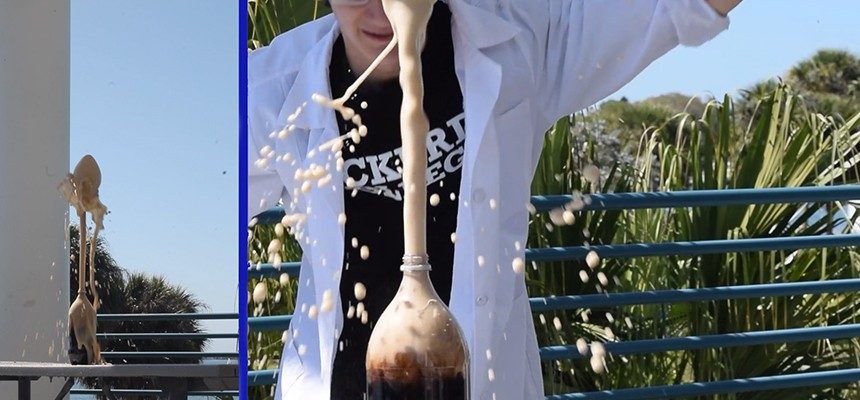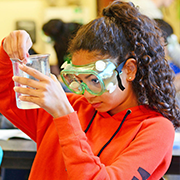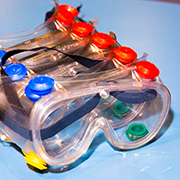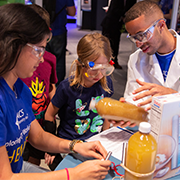Unleashing Carbon Dioxide
Ages
7 - 12 years
Activity Time
15 mins (depending on number of materials sampled)
Group Size
* Participants work in pairs/trios
* 1 facilitator per 5 groups
ACS Student Chapter at Eckerd College Presents: Unleashing Carbon Dioxide
- Solubility of gases: Carbon dioxide is a gas that dissolves in water, and its concentration increases with pressure
- Nucleation sites: Rough surfaces provide sites for gas bubbles to form, so the gas can come out of solution
- Reacting Mentos and soda is exceptionally messy and best conducted outside
- Zero-sugar beverages are best for this activity, as sugar-containing beverages will leave behind a sticky mess
- Potential hazards include:
- Pressurized containers
- Spills and splashes
- Conduct your own RAMP assessment prior to presenting this activity.
Each group should be provided:
- Single serving colorless carbonated drink, such as club soda or diet lemon-lime soda, unopened
- Non-paper straw, such as plastic, silicone, or metal
- Chenille wire or pipe cleaner
- Clear plastic cup
- 1 roll Mentos candy
- ~100 g sand (there will be some left over)
- ~70 g pebbles (ex. aquarium pebbles)
- Three 2-liter bottles of zero sugar soda
- Tape
- Markers
- Construction paper
- Scissors
- Index cards
- Any additional materials identified in your RAMP analysis
Prior to Activity
Customize Activity to Venue
- Review RAMP safety worksheet for this activity.
- Revise procedure to adapt to your specific venue and participants.
- List appropriate procedures for accidents, emergencies.
Identify Safety Practices
- Wear appropriate personal protective equipment (e.g., goggles, gloves, etc.).
- Secure loose hair, clothing.
- Prohibit eating, drinking.
- Clean work area, wash hands after activity.
- Other practices identified in RAMP worksheet.
Prepare Materials
- Cut a piece of paper so that its width equals the length of a roll of Mentos.
- Wrap the paper around the pack of Mentos to make a tube. Use tape to secure the tube.
- Slide the Mentos down to one end of the tube. Mark how far the Mentos reaches inside the tube. Remove the pack of Mentos from the tube.
- Repeat until you have 3 tubes.
On-Site
For each group:
- Provide a cup, colorless soda, a straw, a chenille wire, and one Mentos candy.
- In an open, easy-to-clean space, provide 3 bottles of soda, 3 paper tubes, and equal volumes of sand, pebbles, rolls of Mentos, and three index cards.
-
Examine a Straw
Instructions
Note: Keep all carbonated beverages sealed until ready for use.Direct participants to:
- Open the colorless beverage. Tilt the cup and slowly pour the soda down the inside of the cup to make as few bubbles as possible.
- Place a straw in the soda and look at the straw from the side.
Talking Points
- Roughly how many bubbles are on the straw?
- What are the bubbles? Why are they forming?
- Open the colorless beverage. Tilt the cup and slowly pour the soda down the inside of the cup to make as few bubbles as possible.
-
Compare the Surfaces of a Straw and Chenille Wire
Instructions
Direct participants to:- Place a chenille wire/pipe cleaner the soda
- Look from the side to see if bubbles also form on the chenille wire.
Explain that carbon dioxide bubbles form wherever there is a nucleation site. Chenille wire has a lot more surface than a plain straw. (See Explore the Chemistry)
Talking Points
- Which has more bubbles—the straw or the chenille wire?
- What else do you think would have the same result as the chenille wire? Why?
- What do you think would happen if you did this again with cold soda?
- Place a chenille wire/pipe cleaner the soda
-
Compare the Surface of Mentos to Straw and Chenille Wire
Instructions
Direct participants to:- Place 1 Mentos candy in the soda.
- Watch the candy from the side to see what happens.
Talking Points
- How do the bubbles on the candy compare to the straw and chenille wire?
- What can you conclude about the surface of the candy?
-
Fill Tubes with Mentos, Pebbles, and Sand
Instructions
Direct participants to:- Fill one tube to the mark with unwrapped Mentos. Use index card to hold the contents of the tube in place.
- Fill another tube to the mark with pebbles. Use index card to hold the contents of the tube in place.
- Fill the third tube to the mark with sand. Use index card to hold the contents of the tube in place.
Talking Points
- What do you think will happen when you add each to the soda?
- Which do you think will have the most nucleation sites?
- Fill one tube to the mark with unwrapped Mentos. Use index card to hold the contents of the tube in place.
-
Test Mentos, Pebbles, and Sand
Instructions
Direct participants to:- Open one bottle of diet soda and set it on a flat surface.
- Put the open end of your tube of Mentos on the index card and place it directly over the opening of the soda bottle.
- Remove the card and let all the Mentos drop into the soda at once and quickly move out of the way.
- Repeat with remaining soda, pebbles, and sand.
Talking Points
- Which produced the highest fountain—the Mentos, pebbles, or sand?
- The fountain experiments used the same volume of Mentos, pebbles, and sand. What would be different if you used the same mass of Mentos, pebbles, and sand?
- What happens if you use different types of soda to make the fountain?
- Open one bottle of diet soda and set it on a flat surface.
-
Clean Up
Instructions
- Dispose of all solids from this activity in the trash.
- Dispose of all liquids down the drain.
- Clean all work surfaces with water or a damp cloth.
- Wash hands thoroughly.
Here are some key themes to explore with the audience once they've completed the activity. Adjust the details to match the level of your audience.
Gases can dissolve in liquids. For example, fish breathe gaseous O2 dissolved in water, and the excess CO2 in the atmosphere is what is currently affecting the acidity of the oceans.
You can determine the amount of gas dissolved in a liquid using Henry’s Law:
C = kPgas
where C = the concentration of the gas in solution
k = Henry’s Law constant (for a given gas and solvent at a given temperature)
Pgas = the partial pressure of the gas above the solution
As Henry’s Law shows, the higher the pressure of a gas over a liquid, the greater the concentration of that gas in solution.
To create the fizz in soda, the soda solution is super-saturated with CO2, then stored under even more CO2 to keep the gas in solution. When the bottle is opened, the excess gas rushes out. The CO2 that remains in solution starts collecting on any available bumpysurfaces. The surfaces provide nucleation sites, where the CO2 molecules collect and form bubbles.
All the items you put in the soda aren’t really as smooth as they look with just your eyes. If you could look at the straw, pebbles, and Mentos with a super-strong microscope you would see that they have tiny dents, scratches, and bumps on them. All of these features create additional surface. So, a straw has some extra surface that you can’t see with just your eyes. And the chenille has even more surface than a straw, thanks to its fluffy fibers, which is why it collected more bubbles.
Not only is the surface of the Mentos bumpier than it looks, it develops even more pits and ridges as the sugar in the candy’s coating dissolves in the water of the soda. Additionally, that candy coating also contains gum arabic, a stabilizing agent that also reduces the surface tension of the soda, allowing bubbles to escape more easily.
References
- American Chemical Society, 2023
- ACS Student Chapter at Eckerd College





